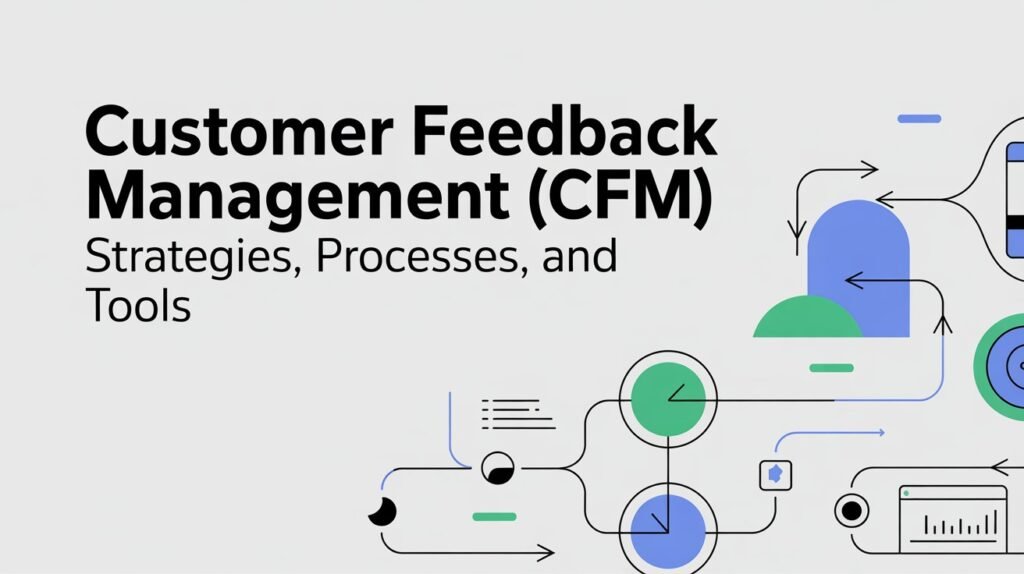What Is Customer Feedback Management?
Customer Feedback Management (CFM) is about collecting feedback from customers across various channels and effectively utilizing it. It’s about really listening to what people want, figuring it out, and using that info to make smarter business decisions. If you have a solid CFM plan, you can focus on your customers, improve your products, offer better services, and keep them coming back.
In today’s cutthroat world, what your customers think really matters. Feedback isn’t just for fixing problems—it helps you improve constantly, come up with fresh ideas, and keep your customers happy. Companies that handle feedback well usually outperform those that ignore it.
The smart way to do CFM is often referred to as the “customer feedback loop” or the A.C.A.F. loop. It has four main stages:
- Ask: Actively ask for feedback on products, services, or experiences.
- Categorize: Organize feedback into segments that match your business goals.
- Act: Implement changes based on what you’ve learned to enhance your offerings.
- Follow-up: Close the loop by letting customers know what actions you took to address their concerns.
Nowadays, businesses rely a lot on software and technology to gather, sort, analyze, and act on feedback more efficiently.
Why Is Customer Feedback Management Critical?
Collecting feedback is one thing; managing it well is another. So, why bother with a CFM strategy at all? Here’s why it’s crucial:
- Reduced Churn: Listening to your customers keeps them around. Even a 5% boost in retention can increase profits by up to 95%.
- Better Products and Services: Feedback reveals what’s working, what’s not, and where to make improvements.
- Stronger Customer Relationships: People feel valued when their opinions actually matter.
- Revenue Growth: Happy customers stay and spend more.
- Understanding the Customer Journey: Feedback shows what influences their buying decisions.
Statistics show that approximately 68% of customers leave because they feel ignored, while 83% remain loyal if their complaints are handled correctly. That really proves why a structured CFM approach is so important.
Steps in Customer Feedback Management
Every company has its own style, but the most effective CFM processes follow these steps.
Step 1: Collecting Feedback
The first stage, “Ask,” focuses on gathering customer insights. You can do this via:
- Surveys and questionnaires
- Focus groups and interviews
- Emails, texts, and live chat requests
- Social media monitoring
- Third-party review sites
Old-fashioned methods, such as focus groups, can provide detailed information, but using modern software can yield the same information faster and on a larger scale. Users can now send surveys automatically, track scores, and view real-time feedback on people’s satisfaction.
Step 2: Analyzing Feedback
Getting feedback doesn’t mean anything if you don’t try to understand it. Customer feedback management software consolidates all your data in one place, allowing you to quickly identify what’s popular, recurring issues, and areas for improvement.
Common metrics include:
- Customer Effort Score (CES): How much work your customer has to do to solve their problem.
- Customer Satisfaction Score (CSAT): How happy people are with what you’re selling.
- Net Promoter Score (NPS): How likely people are to tell others about your company.
Feedback is also categorized—like by product, service, or customer segment—to make decision-making easier.
Step 3: Acting on Feedback
The feedback is only helpful if you make some changes and act on that issue. Make sure the right people see it—marketing, product, sales, or customer support.
Actions might include:
- Give tasks to people on your team
- Use automated systems to keep track of what’s been improved
- Set achievable goals to track success
If customers are saying a product is too hard to figure out, then add a more straightforward process to get started, or some guidance. Once you make changes, verify their effectiveness by checking the customer satisfaction scores.
Step 4: Following Up
It’s essential to close the loop. Many customers believe their feedback doesn’t matter. Following up lets them know that their opinion counts.
Follow-ups can include:
- Personalized thank-you emails
- Updates on changes or new features
- Forums or feedback hubs to track progress
Being open and friendly in those follow-ups will help you attract more loyal customers, build trust, and enhance your business’s reputation.
Effective Ways to Get Customer Feedback
Not all feedback channels are equal. Some top ones include:
- Customer Interviews: Deep insights, but time-consuming.
- Text and Email Surveys: Reach a large audience easily.
- Live Chat Feedback: Real-time insight, but resource-heavy.
- NPS/CES/CSAT Scores: Quick and easy for customers.
- Third-party Review Sites: Shows public perception and benchmarks.
- Social Media Monitoring: Customers often share honest opinions online.
CFM platforms usually combine all these channels for easier management.
Steps for Managing Customer Feedback
- Gather Feedback: Centralize inputs from multiple sources to streamline the process. Avoid vague questions.
- Extract Actionable Insights: Identify specific suggestions for improvements. Follow up if needed.
- Prioritize Action Items: Not all feedback is equal. Use frameworks like RICE or Value-Effort to decide what to do first.
- Execute and Measure: Implement changes, track metrics, and monitor KPIs. Tools like Jira, Mixpanel, or Google Data Studio can help.
- Close the Feedback Loop: Inform customers about the actions you took in response, via email, changelogs, or personalized messages.
Closing the loop boosts satisfaction, loyalty, and retention, while giving you better insights into your customers.
Conclusion
Managing customer feedback isn’t just something you do—it’s about putting them first. Gather feedback, review it, take action, and follow up. Do that consistently, and you can build better products, improve services, and make your customers genuinely happier.
A solid CFM plan means businesses don’t just hear customers—they listen, take action, and keep improving. And honestly, that’s what often sets you apart these days.
Want more to read? Visit dDooks.


